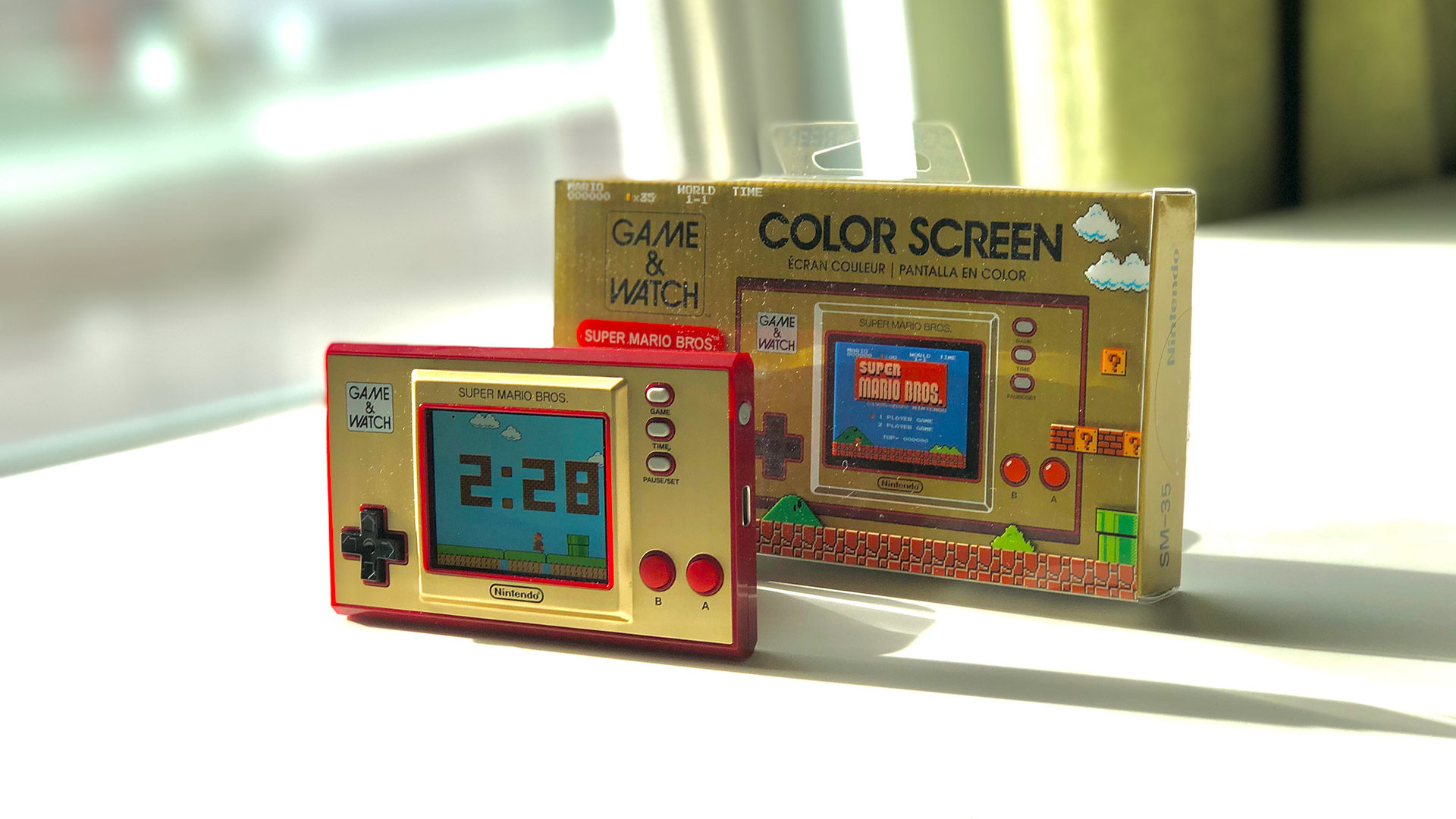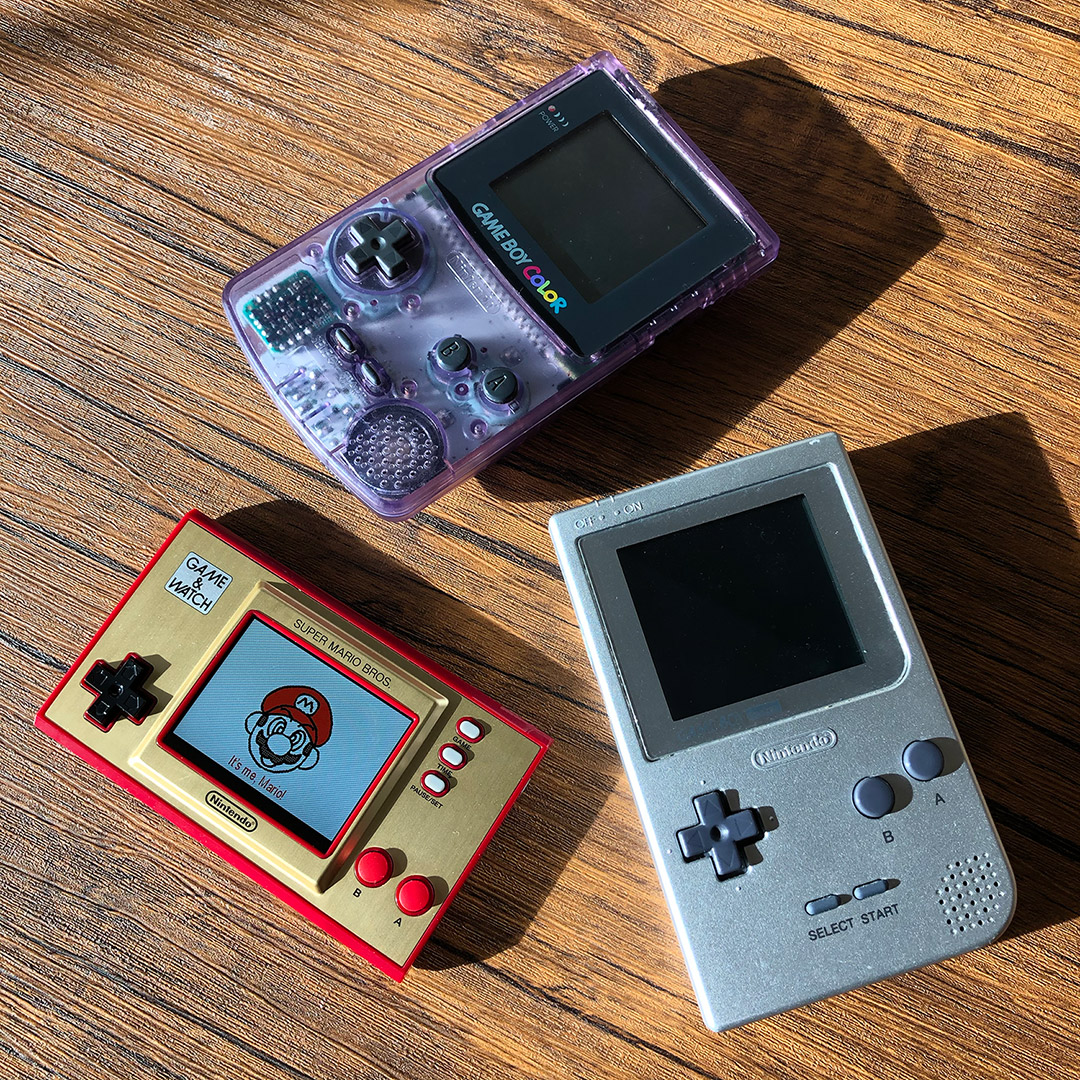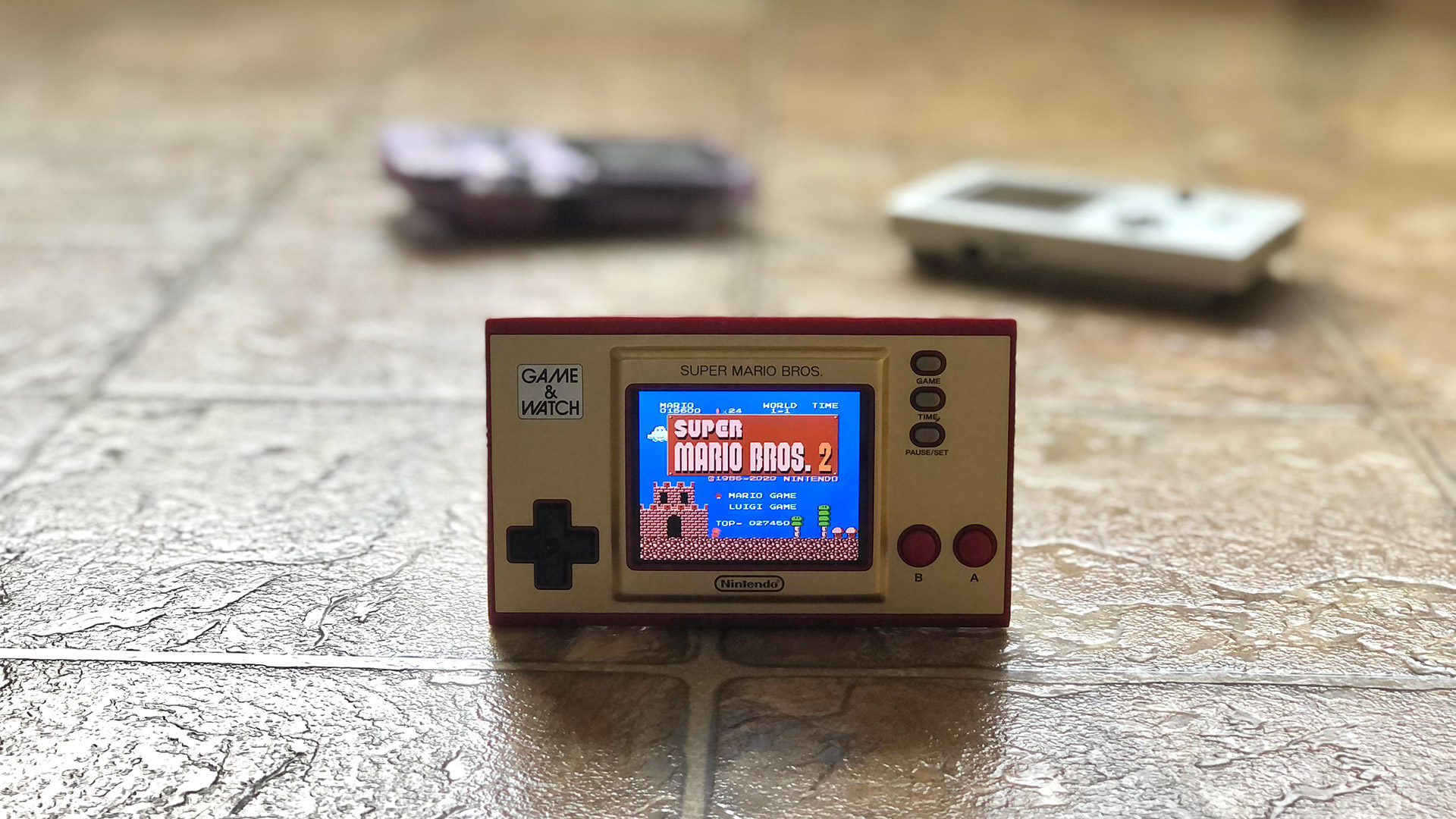Following the runaway success of the NES and Super NES Classic Editions, there were two popular theories on what Nintendo might do next. Some naturally assumed that an N64 Classic Edition must be coming, while others—such as myself—thought the company might instead shift gears and release a Game Boy Classic Edition, given the benefits advancements in screen and battery technology could bring.
Well, we were both wrong—but at least I get to say that I was less wrong. Nintendo’s latest all-in-one product is a handheld, but it instead pays homage to the company’s much earlier efforts in portable gaming. Game & Watch: Super Mario Bros. is styled around the single-screen version of the Game & Watch, a series of handheld electronic games based around older liquid-crystal displays.
Created by legendary Nintendo designer Gunpei Yokoi, the idea was to create lower-cost, self-contained pieces of gaming hardware that could play one simple video game while also featuring rudimentary clock functions (hence the name). The Game & Watch line would go on to help fuel a massive industry of similar handhelds from companies like Tiger Electronics, put Nintendo on a path for greater portable ambitions, and even inspire the design of some of the company’s later products, such as the Nintendo DS (which resembles the dual-screen iteration of the product line).

So, there’s a lot of history and legacy behind Game & Watch: Super Mario Bros., and for any longtime fans of video games, that’s quickly apparent. The classic combination of azuki red and brushed gold metal that’s adorned everything from the original Famicom to the 20th Anniversary Game Boy Micro still looks fantastic here, conjuring up feelings of technology that’s both retro and futuristic. That extends to the overall design of the unit as well, as Nintendo’s Game & Watch models have a timeless quality to them that so many other similar products lacked. Even as someone who was always Sega over Nintendo in the formative days of my youth, there’s something that remains so iconic about this design, and which makes it exciting to hold even in its modern form.
That’s not to say that Game & Watch: Super Mario Bros. doesn’t bring some modern to that form. The biggest change is that those ancient LCD screens have been replaced with a—well, LCD screen. The idea that two so vastly different types of displays are based around the same technology may be confusing to some, but what matters is that we get a color screen similar to what you’d see on many other modern-day products. The screen Nintendo uses for Game & Watch: Super Mario Bros. isn’t anything fancy, but it’s bright, it’s colorful, and it gets the job done without any major flaws like ghosting. On a visual level, I have no complaints about playing any of the unit’s included games—unless you want to get into that age-old argument over purple vs. blue skies in Super Mario Bros. (they’re blue here).
Instead, any hesitations I have come in interacting with the hardware. Coming from the company that invented the D-pad, Nintendo has been shockingly sloppy in its digital controls in recent years, giving us examples that are too sensitive, not sensitive enough, or imperfect in some other way. Thankfully, the D-pad we get here is fantastic. It feels more like the old Nintendo, and has held up great with everything I’ve put it through. The buttons, on the other hand, are going to be a point of contention. Unlike more modern hard, plastic, springy buttons, Game & Watch: Super Mario Bros takes us back to the days of soft, rubbery, mushy buttons. They do take a bit of adjusting to, but I found them to be perfectly fine past that point. In casual conversations with friends, however, I know some people hate these kinds of buttons, so if you fall into that category, your experience with the unit could be somewhat tainted.
The other physical aspect of Game & Watch: Super Mario Bros. that may cause headaches—or should I say hand aches—is that this is a small piece of hardware. “Ergonomics” and “hand comfort” weren’t exactly considerations when the original Game & Watch line was being developed, and as a nod to those releases, this new hardware remains small and blocky. If you’ve got big hands, you may find the controls cramped, and the natural position of my own hands when holding the system did cause some wrist strain after longer gameplay sessions. These aren’t negatives toward the Game & Watch: Super Mario Bros. unit itself, but toward any piece of gaming tech this small, so it’s simply something that comes with the territory. And, for me, the positives of the system’s size outweigh the negatives. Unlike bigger portables whose rides may be more temporary, this is something you can easily toss into a purse, backpack, or even pocket, and leave there until you find yourself needing a bit of entertainment. That’s been the strength of releases like the Arduino-powered MicroArcades, and I’m glad this segment of products exist, even if usability issues can crop up.

That conversation about “take anywhere” video games directly leads into the one other area of argument over Game & Watch: Super Mario Bros.: its games. The system includes three choices: Super Mario Bros., Super Mario Bros.: The Lost Levels (aka the original Japanese Super Mario Bros. 2), and Game & Watch: Ball. (Oh, and in a very welcome feature, you can pause all of those games and resume them at a later time, so that you don’t lose any progress.) Two NES titles and a recreation of a Game & Watch game is admittedly a small roster of offerings, and I know one of the popular arguments out there is that Nintendo should have included Super Mario Bros. 2 (the Western version) and Super Mario Bros. 3 as well.
I’d like to make a counter argument: No. I honestly don’t think adding more games to the unit would instantly make it better, because that’s not what this kind of device is for. Small, portable game hardware typically exists to give you a fun yet focused gaming experience when you’re in need of short bursts of entertainment, and sitting there stressing over what to play as those minutes tick away isn’t what you should be doing. Nor is this the kind of device you’d want to load up with games and spend hours and hours with.
Instead, I think the answer isn’t more games, but what games the unit offers—and I do believe Nintendo made a mistake in that regard. I’m just going to say it: Super Mario Bros.: The Lost Levels shouldn’t be here. Most people probably aren’t going to play it past a few minutes anyhow, as it’s so difficult and challenging that Nintendo of America didn’t even want to touch it back in the heyday of the NES. You then have to consider that this is a device meant for shorter, more casual play sessions, which goes directly against how you need to play The Lost Levels.
I think a better solution would have been to include the NES port of the original Mario Bros. instead. It’s fun, it’s easy to play, and you can walk away satisfied even if you’ve only got a few minutes to spend with it. That would have given Game & Watch: Super Mario Bros. three distinct kinds of games: longer and more challenging (Super Mario Bros.), more casual, arcade-style (Mario Bros.), and extremely simple for any skill level (Game & Watch: Ball). There is also an argument one could make that, given this is a product released in honor of Mario’s 35th anniversary, Game & Watch: Super Mario Bros. (the game, not this device) should have replaced Ball. I don’t know that making that change would have made the unit markedly better or worse, but it’s something to at least mention.

While that’s the Game portion of Game & Watch: Super Mario Bros., we still have the Watch side. By pressing the “Time” button, a Super Mario Bros.-themed clock pops up, which features the current time rendered in brick blocks as Mario (or occasionally Luigi) runs across various scenes from the game. I don’t know how much use the function will actually get, but it’s pretty neat, and has plenty of the charm Nintendo is known for putting into even its smallest projects. But—couldn’t we at least have gotten a little metal stand embedded into the back of the system like in the olden days, so we could stand the unit up to use as a desk clock, Nintendo? Who’s with me? Nobody?
Finally, at least so far, I’ve got no complaints about battery life. The unit comes with a built-in battery that you charge via USB-C port, although like many other products these days, Nintendo has included one (very short) USB-A to USB-C cable but no actual power adapter. In the week I’ve had the system, I’ve plugged it in once in order to refill the initial battery charge it came with, but that’s been it. Now, to be clear, I’ve been using the system in the way I feel it’s been designed: for shorter, more casual gameplay sessions. Between that, and my twins stealing the unit from my desk whenever they can, I haven’t had to recharge it again. Obviously, with anything battery powered, actual usage results will take a while to fully figure out, and may likely vary from player to player.
It’s easy to go into Game & Watch: Super Mario Bros. with lofty expectations for what a product like this should be, and if you do, you absolutely may feel disappointed. This is not a pseudo Game Boy Classic Edition. This is not a “carry your NES library in your pocket” machine. This is a focused piece of hardware meant to harken back to the early days of Nintendo’s portables, while also providing some gaming fun in a device that’s easy to take with you wherever you go. While there are definitely ways in which this could have been a better product considering what it wanted to be, I still think Game & Watch: Super Mario Bros. is an incredibly cool little device that’ll be fun for players of any age or skill level.
And, if nothing else, it adds a whole new log to the fires of Nintendo speculation—as now we get to wonder if next year will bring a Game & Watch: The Legend of Zelda.
|
★★★★☆
Game & Watch: Super Mario Bros. may not have the robust attractiveness of the NES or SNES Classic Editions, yet it still provides a great gaming experience in its own niche way. Merging the history of Nintendo’s handhelds with more modern tech, there are definitely areas in which Game & Watch: Super Mario Bros. could have been better, but it’s still an undeniably cool and stylish gadget that’s as fun to look at as it is to play. |
Developer Nintendo Publisher Nintendo ESRB E - Everyone Release Date 11/13/2020 |
| Game & Watch: Super Mario Bros. is available on . Primary version played was for . Product was provided by Nintendo for the benefit of this coverage. EGM reviews on a scale of one to five stars. | |

Mollie got her start in games media via the crazy world of gaming fanzines, and now works at EGM with the goal of covering all of the weird Japanese and niche releases that nobody else on staff cares about. She’s active in the gaming community on a personal level, and an outspoken voice on topics such as equality in gaming, consumer rights, and good UI. Check her out on Bluesky and Mastodon.